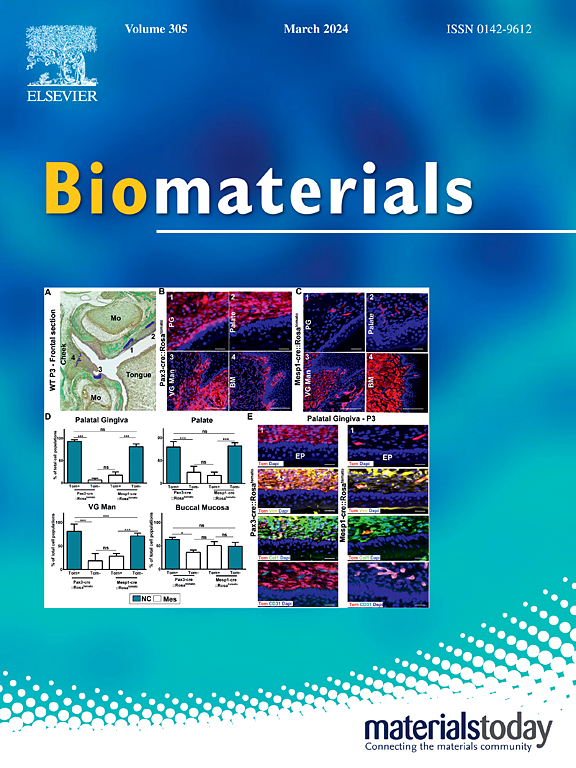Lipid nanoparticles encapsulating both adjuvant and antigen mRNA improve influenza immune cross-protection in mice
IF 12.8
1区 医学
Q1 ENGINEERING, BIOMEDICAL
引用次数: 0
Abstract
The rapid approval of SARS-CoV-2 mRNA lipid nanoparticle (LNP) vaccines indicates the versatility of mRNA LNPs in an urgent vaccine need. However, the mRNA vaccines do not induce mucosal cellular responses or broad protection against recent variants. To improve cross-protection of mRNA vaccines, here we engineered a pioneered mRNA LNP encapsulating with mRNA constructs encoding cytokine adjuvant and influenza A hemagglutinin (HA) antigen for intradermal vaccination. The adjuvant mRNA encodes a novel fusion cytokine GIFT4 comprising GM-CSF and IL-4. We found that the adjuvanted mRNA LNP vaccine induced high levels of humoral antibodies and systemic T cell responses against heterologous influenza antigens and protected immunized mice against influenza A viral infections. Also, the adjuvanted mRNA LNP vaccine elicited early germinal center reactions in draining lymph nodes and promoted antibody-secreting B cell responses. In addition, we generated another adjuvant mRNA encoding CCL27, which enhanced systemic immune responses. We found the two adjuvant mRNAs both showed effective adjuvanticity in enhancing humoral and cellular responses in mice. Interestingly, intradermal immunizations of GIFT4 or CCL27 mRNA adjuvanted mRNA LNP vaccines induced significant lung tissue-resident T cells. Our findings demonstrate that the cytokine mRNA can be a promising adjuvant flexibly formulated into mRNA LNP vaccines to provoke strong immunity against viral variants.
脂质纳米颗粒包封佐剂和抗原mRNA提高小鼠流感免疫交叉保护。
SARS-CoV-2 mRNA脂质纳米颗粒(LNP)疫苗的迅速获批,表明mRNA LNPs在迫切的疫苗需求中具有多功能性。然而,mRNA疫苗不能诱导粘膜细胞反应或广泛保护最近的变异。为了提高mRNA疫苗的交叉保护,我们设计了一种开创性的mRNA LNP,将编码细胞因子佐剂和甲型流感血凝素(HA)抗原的mRNA构建物包封,用于皮内疫苗接种。佐剂mRNA编码一种由GM-CSF和IL-4组成的新型融合细胞因子GIFT4。我们发现,佐剂mRNA LNP疫苗诱导了高水平的体液抗体和针对异源流感抗原的全身T细胞反应,并保护免疫小鼠免受甲型流感病毒感染。此外,佐剂mRNA LNP疫苗在引流淋巴结中引起早期生发中心反应,并促进抗体分泌B细胞反应。此外,我们还生成了另一种编码CCL27的佐剂mRNA,增强了全身免疫反应。我们发现这两种佐剂mrna都显示出有效的佐剂性,可以增强小鼠的体液和细胞反应。有趣的是,皮内免疫GIFT4或CCL27 mRNA佐剂mRNA LNP疫苗可诱导显著的肺组织驻留T细胞。我们的研究结果表明,细胞因子mRNA可以作为一种有前途的佐剂,灵活地配制成mRNA LNP疫苗,以激发对病毒变体的强免疫力。
本文章由计算机程序翻译,如有差异,请以英文原文为准。
求助全文
约1分钟内获得全文
求助全文
来源期刊

Biomaterials
工程技术-材料科学:生物材料
CiteScore
26.00
自引率
2.90%
发文量
565
审稿时长
46 days
期刊介绍:
Biomaterials is an international journal covering the science and clinical application of biomaterials. A biomaterial is now defined as a substance that has been engineered to take a form which, alone or as part of a complex system, is used to direct, by control of interactions with components of living systems, the course of any therapeutic or diagnostic procedure. It is the aim of the journal to provide a peer-reviewed forum for the publication of original papers and authoritative review and opinion papers dealing with the most important issues facing the use of biomaterials in clinical practice. The scope of the journal covers the wide range of physical, biological and chemical sciences that underpin the design of biomaterials and the clinical disciplines in which they are used. These sciences include polymer synthesis and characterization, drug and gene vector design, the biology of the host response, immunology and toxicology and self assembly at the nanoscale. Clinical applications include the therapies of medical technology and regenerative medicine in all clinical disciplines, and diagnostic systems that reply on innovative contrast and sensing agents. The journal is relevant to areas such as cancer diagnosis and therapy, implantable devices, drug delivery systems, gene vectors, bionanotechnology and tissue engineering.
 求助内容:
求助内容: 应助结果提醒方式:
应助结果提醒方式:


